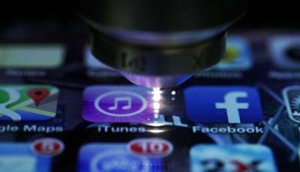19 June 2014. Engineers at École Polytechnique de Montréal and Corning Inc. in Corning, New York designed a process for embedding sensors into the display glass covers on smartphones. The research team led by doctoral candidate Jerome Lapointe published its findings in the 30 June 2014 issue of the journal Optics Express, published by Optical Society of America.
Lapointe and colleagues created their techniques using Corning’s Gorilla Glass that chemically strengthens the outer surface of glass to withstand pressure and resist scratches when used with touchscreens on smartphones and tablets. Corning says Gorilla Glass is found on some 2.7 billion mobile devices across 33 brands.
The researchers adapted laser techniques to inscribe waveguides — a form of electronic channel — that direct light-enabled electrical signals in the glass surface. Current technologies for applying waveguides to surfaces use photolithography, a type of printing, which can create a solid connection, but is a more complex and expensive process. In addition, lasers can embed waveguides in the surface of glass at any depth, including multiple layers on one device, while photolithography applies a circuit only to the surface.
Using the durability of Gorilla Glass, say the researchers, makes for smoother waveguides with less leakage of the signal. The properties of the glass also make it possible to use lower-energy laser pulses, resulting in smoother and more efficient waveguides.
In the paper, Lapointe and associates describe two applications created with laser-inscribed waveguides in Gorilla Glass like that in smartphones. The first is a common temperature sensor using straight and curved waveguides, which the authors say has already been etched in glass with lasers, but not with the kind of low-loss waveguides employed in this project. In the sensor, changes in temperature alter the path length of the waveguides, making it possible to measure those temperature changes.
The second application is a simple authentication system combining waveguides with holes in the surface of the glass that allows light to escape from the surface in a unique pattern. Infrared detectors can then read the light patterns and verify the identity of the smartphone owner. This application, say the authors, could be used as an extra layer of security with near field communication (non-contact) data transmission used increasingly with financial transactions on smartphones.
The university says the two applications are being patented and commercial partners are invited to explore developing the technology.
Read more:
- Mobile App/Sensor Designed to Help Parents Control Stress
- App Measures Health Status with Basic Smartphone Technology
- Study Aims to Boost Wireless Channel Management, Performance
- Simple, Low-Cost Method Adds Microscope Lens to Smartphone
- Smartphone App for Point-of-Care Diagnostics in Development
* * *


 RSS - Posts
RSS - Posts
You must be logged in to post a comment.